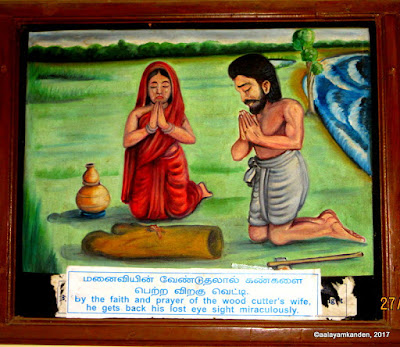 |
| The new church of Our Lady of Glory in Pulicat |
As usual, this post, which should have been written months ago, got buried in my professional commitments along with 30,000 other images waiting to see the light of day.
The waters of Pazhaverkadu were deep enough for the ships of the Arabs, Portuguese and the Dutch to land and trade diamonds, pearls, textiles, herbs and spices. The world famous Palayacatta Lungies originated from Pulicat. The prawns and crabs, caught in the waters of Pulicat, till date are said to be among the tastiest.
One day, when a fisherman cast his net, all that he caught was a log of wood . Angered, he threw it right back into the waters, and went home disappointed. The next day, the same log was caught in his net. This time, the frustrated fisherman, threw the log into the shore, and cast his net again. He ended up catching a huge amount of fish, and went home happily.
A woodcutter, who saw the piece of wood on the shore, started cutting it for firewood. The moment his axe hit the log, blood splashed from it, and he lost his eye-sight. He was wandering about on the beach, weeping, unable to find his way home. His wife, finding that her husband did not return home that evening, went looking for him, and found him, weeping on the beach. On hearing what happened, she found the log. She prayed to it fervently, seeking apology for the unknowing act of her husband. She then collected the blood from the axe, and smeared it on the woodcutter's eyes. This restored his eyesight.
They returned home happily, carrying the log with them. They shared the incident with everyone in the fishing village. The villagers installed the holy log in a hut and started worshipping it. The next year, a Portuguese ship returning from Malacca reached Pulicat and on hearing from the villagers about the holy log, confirmed that it was the wooden idol of Mother Mary which they had lost in the cyclone on the shores of Pulicat when they started to Malacca.
It was the year 1515 CE and they helped the villagers install the wooden idol of Mother Mary in a small shrine, and called her Our Lady of Joy, due to the joy of rediscovering her after losing her in the storm.
Several miracles followed in the years to come. The Lady of Joy helped several people in distress. So her name and fame grew, and the shrine attracted more and more people to it. Because of this, the Dutch who came after the Portuguese, expanded the shrine and called Mother Mary, Our Lady of Glory, a name that refers to the church till date.
Although over time, even the British added architectural additions to the church, the original altar from the Portuguese time remains to date. The church is filled with paintings that depict the history of events and photographs of how the structure has changed over the years.
Sadly, all that remains of the old Portuguese structure is the altar and the house of the priest, that was built at the time the church was, by the Portuguese and redo by the Dutch subsequently. The original church has been pulled down in 2008, to give way to a new and larger building. The original church had been built like a cross with a central arch and praying hall and chambers on either side, It was of typically Gothic architecture style. Aarde Foundation has tried to recreate a model of the church that had been in existence and displays the image of a 3D regenerated model in its small museum.
The church also contains a copy of the decree by the Archbishop of Madras - Mylapore declaring it as the first Parish in Tamil Nadu.
Apart from this church, which still attracts several thousand people from across the world to it because of its glory and miracles, there is another church in Pulicat, the St.Antony's church in the North Eastern side of Kottaikuppam, which still retains its original Dutch architecture and a relic of St.Antony.
Although most of rich heritage of Pulicat has been lost to deliberate destruction and passage of time, it is important that we understand, appreciate and recognise the structures that are still left, before they too undergo transformation and change beyond recognition.
How to get here: Pulicat is about 60 kilometres north of Chennai. GPS coordinates (13.422564, 80.315257)
Contact Details : 044 2797 6460








No comments:
Post a Comment